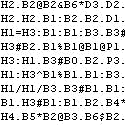 |
 |
 |
REVIEWCampaigns of La Grande Armee 1806By Richard Moore
In 1806 Napoleon Bonaparte launched his Grande Armee at a Prussia clamouring for war against the French emperor. Despite its desire for a military clash, Prussia was caught completely by surprise and its forces were humbled. The battle of Jena was a disaster for Berlin, but the humiliation inflicted upon its military pride by Marshal Davout at Auerstadt - when he crushed a Prussian army almost three times the size of his own - shattered its ability to fight on. Within three weeks of the start of the campaign, Napoleon Bonaparte had captured Berlin and knocked Prussia out of the Fourth Coalition. Much of it had to do with the fact that in Davout, Bonaparte had his finest marshal leading III Corps, possibly the finest body of French troops ever created.
And it is on the logistical side of Napoleonic warfare that Frank Hunter of Adanac Command Studies has concentrated in his very interesting game The Campaigns of La Grande Armee: 1806. It is not a beautiful game - the graphics are basic and the screens and menus simple - but The Campaigns of La Grande Armee: 1806 will entice you in with the promise of things to come and then seduce you with an impossible-to-resist appeal to your grey matter. The map shows you all the major roads, towns and cities - you can switch off their names and also a hexagonal grid - and the military units are represented by boardgame-style square counters. There is no sound, but as Hunter explains (and I agree) having none is better than poor sound. Coming to grips with the command structure and supply details is crucial in the game as your units can find themselves caught out if they run out of food or ammunition. Your army command centre distributes supplies to the various units, as does each city or town you take from the enemy. In the latter case it is a one-off, unfortunately, so you do need to try to grab as many as you can. You do need to be mindful, however, of enemy counterattacks against a force weakened by sending too many units off to forage and - if you are playing the French - the hefty victory point weighting of crossing the Elbe and capturing Berlin. And, with a very fine adjustable fog-of-war aspect to the game - you are never quite sure where or when your corps or divisions will run into the enemy. The overall command pressures placed on you by The Campaigns of La Grande Armee: 1806 really make this game distinct from other Napoleonic titles and make you appreciate how difficult campaigns must have been to organise. Battles are pretty much worked out off-screen although you do get a choice of what style of battle you will fight - holding or pinning actions, a pitched/attack strategy or even withdrawal. The results are calculated by the computer based upon troop morale, fatigue levels, the force mix, commander's rating and the terrain. Another aspect I really liked about The Campaigns of La Grande Armee: 1806 is the importance of fatigue upon troops and if you march your men hard then you will lose an increasing number of them as stragglers. Having a hospital nearby also assists in getting your units back to fighting fitness more quickly. In addition, the time delay between sending orders for a certain objective to be taken and those decisions being acted upon is similar to the very old Napoleonics games and adds realism to the command problems. The one thing I would have loved to have seen on The Campaigns of La Grande Armee: 1806 is a zoom-out function. There is a small strategic map, but a full-screen sized area map would make gameplay so much easier. This game does not suck your computer dry of all its processing power and one of the beauties is you can play it almost full screen with your programme/internet/email shortcuts still on the bottom of your screen. So, if you are sneaky, you can play while at work and not have to keep quitting the game to deal with money-making matters. I can heartily recommend The Campaigns of La Grande Armee: 1806 to gamers who want to really test their mettle as a true commander of Napoleonic Era armies. 80% |
||
|
Napoleon
Bonaparte
|
|
| Career | Portraits |
| Quotes | Family |
| Loves | Letters |
| Plots | Murdered? |
| His will | Places |
|
Era
of Napoleon
|
|
| Powers | Opponents |
| Coalitions | Allies |
| People | Timelines |
| Key sites | Shrapnel |
|
Warfare
|
|
| Campaigns | Battles |
| Armies | Generals |
| Marshals | Winners |
| Glossary | Medical |
| Weapons | 1812 War |
| Uniforms | Battlefields |
|
War
at Sea
|
|
| Naval War | Heroes |
| Artworks | Signals |
| Nelson | Trafalgar |
|
Maps
|
|
| Key Maps | Peninsula |
| Animated | 1796/1800 |
| 1809 | Russia |
|
French
Revolution
|
|
| Revolution | Guillotine |
| Posters | People |
|
Art,
Film, Games
|
|
| Education | Goya |
| Sharpe | Hornblower |
| Books | Movies |
| DVDs | Music |
| Wargames | Images |
| Cartoons | Caricatures |
|
Other
|
|
| About Us | Sources |
| Awards | Sitemap |
| Links | Militaria |
| Miniatures | Reenactors |
| Forum | Quizzes |
| Home | Waterloo Diorama |

